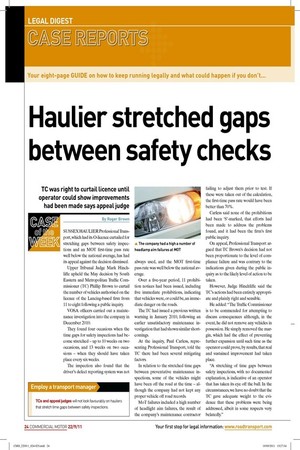Haulier stretched gaps between safety checks
Page 14

If you've noticed an error in this article please click here to report it so we can fix it.
TC was right to curtail licence until operator could show improvements had been made says appeal judge
By Roger Brown
SUSSEX HAULIER Professional Transport, which had its O-licence curtailed for stretching gaps between safety inspections and an MOT irst-time pass rate well below the national average, has had its appeal against the decision dismissed.
Upper Tribunal Judge Mark Hinchliffe upheld the May decision by South Eastern and Metropolitan Trafic Commissioner (TC) Phillip Brown to curtail the number of vehicles authorised on the licence of the Lancing-based irm from 11 to eight following a public inquiry.
VOSA oficers carried out a maintenance investigation into the company in December 2010.
They found four occasions when the time gaps for safety inspections had become stretched – up to 10 weeks on two occasions, and 13 weeks on two occasions – when they should have taken place every six weeks.
The inspection also found that the driver’s defect reporting system was not always used, and the MOT irst-time pass rate was well below the national average.
Over a ive-year period, 11 prohibition notices had been issued, including ive immediate prohibitions, indicating that vehicles were, or could be, an immediate danger on the roads.
The TC had issued a previous written warning in January 2010, following an earlier unsatisfactory maintenance investigation that had shown similar shortcomings.
At the inquiry, Paul Carless, representing Professional Transport, told the TC there had been several mitigating factors.
In relation to the stretched time gaps between preventative maintenance inspections, some of the vehicles might have been off the road at the time – although the company had not kept any proper vehicle off road records.
MoT failures included a high number of headlight aim failures, the result of the company’s maintenance contractor failing to adjust them prior to test. If these were taken out of the calculation, the irst-time pass rate would have been better than 70%.
Carless said none of the prohibitions had been ‘S’-marked, that efforts had been made to address the problems found, and it had been the irm’s irst public inquiry.
On appeal, Professional Transport argued that TC Brown’s decision had not been proportionate to the level of compliance failure and was contrary to the indications given during the public inquiry as to the likely level of action to be taken.
However, Judge Hinchliffe said the TC’s actions had been entirely appropriate and plainly right and sensible.
He added: “The Trafic Commissioner is to be commended for attempting to discuss consequences although, in the event, he did not remove any vehicles in possession. He simply removed the margin, which had the effect of preventing further expansion until such time as the operator could prove, by results, that real and sustained improvement had taken place.
“A stretching of time gaps between safety inspections, with no documented explanation, is indicative of an operator that has taken its eye off the ball. In the circumstances, we have no doubt that the TC gave adequate weight to the evidence that these problems were being addressed, albeit in some respects very belatedly.”




































